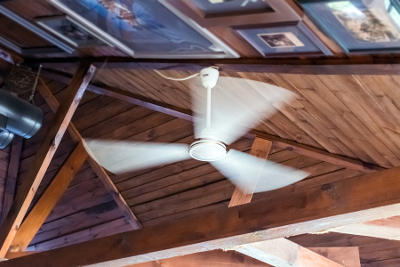
February 17th, 2020 by
Ceiling fans are a great way to keep cool in summer. They improve the airflow of a room and stop the air from getting stale. However, what many people don’t realise is that their ceiling fan can be used to keep warm in winter, too! By reversing the direction of its rotation you can make your fan push warm air down to ground level, helping to reduce your heating bills and making your room feel much cosier.
To learn more about how to do this and how it works, keep reading!
Why Does Ceiling Fan Direction Matter?
 You probably know that, when a room has poor airflow, the air sits and gets very hot. You also probably know that warm air rises. The idea behind a ceiling fan is that it gets that stale warm air moving and pushes it back down to ground level; as the air moves against your skin, it creates a wind chill effect that makes the room feel cooler. This is known as a downdraft.
You probably know that, when a room has poor airflow, the air sits and gets very hot. You also probably know that warm air rises. The idea behind a ceiling fan is that it gets that stale warm air moving and pushes it back down to ground level; as the air moves against your skin, it creates a wind chill effect that makes the room feel cooler. This is known as a downdraft.
Downdrafts occur when your fan spins counterclockwise. When it spins this way, the warm air near the ceiling is sucked through the fan and pushed towards the ground. When your fan spins clockwise, however, it creates something called an updraft which has the opposite effect.
Updrafts suck cool air up from ground level and gently pushes warm air – which naturally rises above the ceiling fan – up and away. This warm air is pushed along the ceiling and down the walls to ground level. Now, this should in no way replace a good central heating system, but it will complement it nicely by distributing the warm air from your radiators more effectively. This could help you save around 15% on your heating bills!
How to Reverse the Direction of Your Ceiling Fan
Almost all modern ceiling fans let you reverse their direction with the flip of a switch. Consult your instruction manual to find out where this switch is on your model. It’ll usually be somewhere on the central hub of the fan.
If the switch is horizontal, flip it to the left to create a downdraft, which will keep you cool in summer. Flip it to the right to create an updraft, which will keep you warm in winter. If the switch is vertical, flip it down for a downdraft and up for an updraft.
If your fan is remote controlled, changing fan direction is even easier – just use your remote! It’s worth bearing in mind that some remote control ceiling fans might not have an integral switch onboard the unit, so it’s important to take good care of your remote.
Westinghouse Princess Euro Dark Pewter/Chrome 42 Inch Ceiling Fan
Price: £123.38
Buy Now
Altering Blade Pitch to Reverse Airflow
If your ceiling fan is very old it might not be able to reverse direction. However, there is still a way you can use it to generate an updraft. All you need to do is adjust the pitch of the blades! Adjust your blades so they slope the opposite way and set your fan running. There’s a simple test you can do to check whether you’ve got it right: just stand beneath your fan! Stand slightly off from the centre of your fan and see if it’s blowing a downdraft towards you. If you can’t feel anything then you’ve got it right.
Comments
Leave a reply
Your e-mail address will not be published. All fields are required


